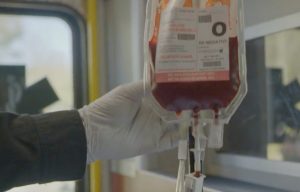
When Loudoun County fire and rescue personnel arrived on the scene of a serious motor vehicle crash, it was clear the patient had the potential for critical injuries. Still trapped in a vehicle lying on its side, the 66-year-old woman was conscious and responding, but bleeding from an 8-inch laceration on her scalp. Her skin was pale and warm to the touch, and her pulses were weak.
Following extrication, the patient was moved to the ambulance, where her blood pressure was found to be just 61/28 and her heart rate 55 bpm. She remained pale and her skin felt cool. She was alert but slow to respond.
Capt Golino: “In speaking to the paramedics immediately after the incident, Lieutenant/Paramedic Josh Pebler and Firefighter/Paramedic Ashley Mixell suspected both a possible brain injury and also other internal injuries and knew she needed to get to a trauma center. But with how she presented, they were worried she could seriously deteriorate during the 30 minutes it would take to get her there.”
The paramedics decided to infuse a unit of whole blood to improve perfusion. Since 2020, Loudoun County EMS supervisors have carried whole blood through a collaboration with other regional EMS agencies and a local hospital system. The team initiated IO access in the patient’s humeral head and began administering the blood using the LifeFlow PLUS volume resuscitation device (along with the QinFlow Warrior to warm the blood).
The entire unit of blood was administered in approximately 3 minutes. Unfortunately, the patient’s blood pressure remained low. After consultation with the medical director, the decision was made to switch from blood to normal saline. Thanks to LifeFlow, the EMS clinicians could safely and quickly administer the intended amount of fluid—in only 7 minutes they infused 1800 mL of normal saline.
“In the past, we might’ve been wasting time getting large-bore IV access and then just running a bag of fluid wide open, without much control over how fast and how much fluid we give,” Golino said.
Their care helped stabilize the patient, and prior to arriving at the trauma center her blood pressure had risen to 110/72 and her heart rate had also increased to 64. Most important, she also had improved mental status and skin color. The trauma team determined she had 2 subarachnoid hemorrhages and a concussion, and her scalp wound required 9 staples and 11 stitches to close. Happily, she was discharged walking and alert just 5 days later.

